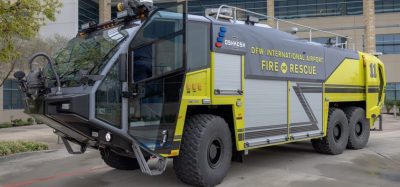Innovation and customer experience as levers for transformation
- Like
- Digg
- Del
- Tumblr
- VKontakte
- Buffer
- Love This
- Odnoklassniki
- Meneame
- Blogger
- Amazon
- Yahoo Mail
- Gmail
- AOL
- Newsvine
- HackerNews
- Evernote
- MySpace
- Mail.ru
- Viadeo
- Line
- Comments
- Yummly
- SMS
- Viber
- Telegram
- Subscribe
- Skype
- Facebook Messenger
- Kakao
- LiveJournal
- Yammer
- Edgar
- Fintel
- Mix
- Instapaper
- Copy Link
Posted: 26 May 2023 | Amparo Brea | No comments yet
In Issue 1 of International Airport Review, Amparo Brea, Director of Innovation, Sustainability & Customer Experience at Aena, shares how the operator is harnessing digital solutions to innovate and evolve passenger experience, driving the concept beyond today’s standards.


Innovation and digital solutions are key for Aena's transformation.
Aena is an airport operator company that currently manages 80 airports around the world. We manage 46 airports and two heliports in Spain, London Luton in the UK, 17 airports in Brazil (11 of them recently joined) and participate in the management of 12 airports in Mexico, two in Colombia and two in Jamaica. In 2019, more than 367 million passengers passed through our airports.
Aena is a leading company due to its experience, capacity and professional team in the management of airport services. Our airports are among the most modern and functional in the world and are equipped with the most advanced technologies.
By anchoring to human needs as the starting point for innovation, outcomes and value creation become everyone’s responsibility
We are witnessing the evolution in the way of thinking about experiences that is encouraging companies to go beyond the concept of customer experience (and to organise all their activities to offer exceptional experiences to their customers).
Anchoring to human needs
Innovation is changing. By anchoring to human needs as the starting point for innovation, outcomes and value creation become everyone’s responsibility, and problems are being solved in fundamentally new ways.
These experiences must respond to new needs, often unmet, and usually changing needs and to customer expectations, allowing them to achieve the results they want. This means causing a change in how we relate to customers, going from optimising contact points with the customer based on products and services, to responding to human needs with a purpose.
We define the strategy in response to the needs and expectations of the wishes according to the type of our client:
- Traveller experience: seamless, genuine, next generation mobility, sustainable choice
- Airport community experience: airlines, commercial operators, corporate, third parties beyond the airport
- Employee experience: information and transparency, employee commitment, employee empowerment and training.
To become the business of experience, we must transform the way we relate to customers from a relational approach, where the points of contact with the customer for products and services are optimised, to an experiential approach, where the needs and expectations of the customers’ desires are responded to.
In this way, we leverage this transformation on a mindset change (new ways of collaboration and co-creation), through innovation (solving problems in new ways) and evolving the digitalisation as key levers to achieve our goal.
Harnessing digital technology
We aim to become the axis of the airport ecosystem experience, so we can position Aena as an international leader in the use of digital tools with the objective of optimising the customer experience, increasing operational efficiency and developing new businesses around sustainable mobility.
Our innovation and digital transformation are based on using technology to improve current business and to develop new businesses, and at the end of 2021, we launched our Innovation Strategic Plan, which is made up of these three fundamental pillars:
- From passenger to client: exploit the data to reach the individual knowledge of the passengers who use the airport in order to offer them a personalised experience
- Efficient use of resources: automate airport management processes and evolve towards as-a-service models
- Beyond the airport: explore new business areas around sustainable mobility.
Biometrics
A clear example of the materialisation of Aena’s innovation, digital transformation and customer experience strategy is the successful case of the implementation of biometrics in Aena airports.
Since 2019, we have carried out three different biometric trials in Menorca (MAH), Adolfo Suarez Madrid – Barajas (MAD) and Josep Tarradellas Barcelona – El Prat (BCN) airports before launching our first phase of biometric deployment in Aena airports. Our pilots were incremental, which means that we added a new use case in each new pilot, until achieving a full biometric journey from home to the boarding gate. We made each pilot with a different airline and different technological suppliers, so we could engage different stakeholders, test different solutions and ensure that the market is ready before deploying biometrics in large scale.
The success of these use cases has been demonstrated by the good results obtained and in the case of the BCN project, having been awarded by ACI World as the best innovation in airport passenger related processes in the Innovation Awards 2022.
The concept is based on identification technology through the recognition of the physical and non‑transferable characteristics of people. When the passenger registers in the biometrics programme, a biometric single token ID of the passenger is created, made up of ID document and/or passport data, the biometric feature and the boarding pass. As a biometric feature, we use facial recognition: it is touchless and less intrusive than other types of biometric recognition. Thus, this token allows passengers to go through various airport touchpoints just showing their faces, without needing to show ID documents or their boarding pass. Currently, Aena is the sole owner of the biometric database and therefore responsible for its management. This entire process is carried out with the consent of the passenger and in compliance with the official data protection law in force.
Deploying the first phase of biometrics in our airports
After carrying out these three pilot projects, the first phase of biometric deployment in Aena airports has been given the green light.
Having the advantage of being a network and that Aena is the owner of the biometric database, our idea is that passengers just need to enrol once (the first time they fly), and we can save and keep this enrolment in our database, removing the need for them to repeat this step the next time they fly.
Once the passenger has registered and the biometric token has been created, this registration is valid until the ID document expires or up to two years if the service is not used frequently and can be updated by the passenger at any time. In this way, we ensure that a passenger already registered in the biometric programme does not have to complete any extra steps to use biometrics when travelling on future occasions. Every time the passenger checks-in with an airline taking part in the biometric programme, the boarding pass obtained will be automatically associated with the identity token stored in the biometric database.
Therefore, this unique enrolment allows travelling using biometrics from any airport in the network and with any airline that participates in the biometric programme.
In our biometric strategy, it is planned to progressively incorporate more touch points at the airports in which biometrics can be used in order to achieve a full seamless and touchless customer journey.
This biometric project is one of the many examples where Aena has opted for using innovative technology to improve the experience of its customers, to optimise airport processes and to transform its airports so that they are at the forefront of the sector.


Since she joined Aena in 1996, she has been Director of Infrastructures and Director of Planning and Environment and a member of the Board of Directors of companies related to airport infrastructures. She is currently Director of Innovation, Sustainability and Customer Experience and Chief Green Officer of Aena.
An Aeronautical Engineer from the Polytechnic University of Madrid, Amparo has obtained the title of Project Management MPM (CEU), has completed the Senior Business Management Program -PADE (IESE) and the Digital Transformation Program (IESE).
Issue
Related topics
Biometrics, Digital transformation, New technologies, Passenger experience and seamless travel, Sustainability, Terminal operations
Related airports
Adolfo Suarez Madrid – Barajas (MAD), Josep Tarradellas Barcelona – El Prat (BCN), London Luton Airport (LTN), Menorca Airport (MAH)
Related regions
Central and South America, Europe, United Kingdom and Ireland


















